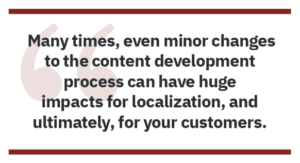By Kit Brown-Hoekstra | STC Fellow
Making your content more global-ready improves customer satisfaction, reduces localization costs, minimizes friction in your product development lifecycle, and improves your global brand identity.
Localization is an important, yet often neglected, component of your content organization. Even if your organization does not currently localize content for a global audience, you need to incorporate global readiness into your content strategy, engineering, and operations.
Here’s why:
- 21.9% of the U.S. population are non-native English speakers.1
- 43% of the Canadian population are non-native English speakers.2
- While approximately 1.5 billion people speak English (19% of the world’s population), only 370 million speak it as a native language. The remainder speak English with varying degrees of fluency.3
- 66% customers surveyed prefer to buy products in their native language, and 75% say they would be more likely to be loyal to a brand if the product was localized.4
- Many countries require local language availability, particularly for regulated products like medical devices, financial products, etc. Lack of an effective global content strategy restricts your organization’s growth and market share.
- Localization is a garbage in/garbage out process. If your source content is not structured and global-ready, the content is likely causing significant costs in localization.
- Making your content global-ready also better serves your customers with accessibility needs, and increases your ability to quickly respond to new demands.
Global-ready content improves customer satisfaction, reduces localization costs, reduces friction in your product development lifecycle, and improves your global brand identity. Many times, even minor changes to the content development process can have huge impacts for localization, and ultimately, for your customers.
Analyze
When bringing localization into your content strategy, you need to gather some baseline data:
- List strategic business objectives and key performance indicators (KPIs) that your organization is working toward.
- Assess the volume of content produce annually and percentage localized.
- Identify current locales and number of languages.
- Forecast planned locales and languages for one, three, and five years out.
- Set the annual localization budget.
- Estimate the desktop publishing and engineering costs for both source content and localized content.
- Research the cost of creating and localizing source graphics.
- Assess the successes and pain points that the localization service provider has when working with you.
- Survey in-country reviewers, global customer service, and global business unit counterparts to identify what’s working and what’s not.
- Measure the maturity of terminology management, quality assurance, change management, and lifecycle governance processes.
- Calculate the percentage of fuzzy matches in translation memories (Hint: a lot of 95%–98% matches indicate that preferential changes are being made to previously translated content.)
- Review the style guide and other governance documents.
- Calculate the percentage of duplicate content across product lines and opportunities for reuse.
- Identify the tools being used for authoring, production, distribution, etc.
- Note the channels being localized for each market and who is responsible for managing (e.g., local business unit, central content team, localization provider, or someone else).
- Audit content, architecture, templates, systems, and processes for other issues that affect localization.
Once you understand the landscape, you can identify priorities, begin planning, and establish effective metrics. As you develop the strategy, be sure to connect your plans back to the overall organization goals. Doing so will help you sell any budget requests to upper management and will help you promote content as a business asset.
Plan
Unless you are working for a startup, it’s likely that you will be retrofitting your content system to better support global readiness and localization. This requires you to prioritize as you start designing with the world in mind. Your analysis should give you a good idea of where to start incorporating localization into your strategy.
Remember, content strategy is an ongoing process, so build continuous improvement into your system. Look at your content holistically as you begin incorporating localization, starting with items that are easy or inexpensive to do, but have a huge impact.
Generally, making your source content and processes more global-ready can cut your localization costs by 20% or more. For example, if you create a graphic that costs $50, but has to be modified for 20 locales, the real cost of that graphic is $1,000. Now, multiply $1,000 by the number of graphics, and you can quickly see how small issues in the source content can completely blow your localization budget. As another example, if your writers are re-creating notes, cautions, and warnings instead of reusing them, you are 1) paying multiple times to translate the same content, 2) potentially increasing your company’s liability if safety information isn’t worded exactly the same, and 3) causing the writers to spend time that could be better spent on something else.
As you are planning, think about ways you can bake quality and global-readiness into your content and systems.
Build
Designing with the world in mind means working with content engineering, operations, and authoring to make sure that all your structures, processes, models, frameworks, etc., support and facilitate both source content development and localization for both text and visual content.
These frameworks need to be flexible and solid enough to accommodate new technology, channels, and so on, without collapsing under their own weight or getting blown away by the first problem.
Some good questions to consider include:
- Is your content well-structured and componentized, so that you can send batches of content to localization as it is approved?
- How does your workflow support localization?
- How do you store the localized content so that it is accessible to the correct channels?
- Does your semantic model support localization?
- If your product is software, are the user interface field labels stored in a way that is accessible to both localization and for single sourcing with the source content?
- Is your change management process proactive?
- Have you considered implementing controlled language?
- What can you systematize and automate to make the process more consistent and efficient?
In addition, terminology management needs to happen above the project level in order to be truly effective. Consistency across product lines helps reduce localization costs while improving your semantic model, taxonomies, search engine optimization, as well as your overall customer experience.
Your global content strategy is only as good as the system’s ability to implement it.
Scale
Localization tends to increase system complexity exponentially as new languages are added. Most companies can limp along with manual processes when they just have one to three languages. Once companies start localizing five or more languages, however, they need a more robust and effective system.
Structured authoring, content management systems, ongoing user/customer research, and appropriate automation allow you to scale efficiently as you bring in new channels, audiences, and markets. Making your content more intelligent also helps you improve personalization, usability, and so on.
Building the frameworks to support content creation and management across the organization will improve the consistency and quality of not only the content, but also the customer experience as a whole.
By measuring your baseline and then implementing metrics to track improvements, you can demonstrate the value of your content to the business and to your customer journey.
Conclusion
Localization should be part of your global content organization and not treated as a separate activity. To effectively pull in localization, first analyze and measure your current state, and identify where you can achieve the greatest impact for the lowest cost and least time. Then, build your roadmap and get started.
Remember, continuous improvement is the key to success. Your content strategy and roadmap should be living documents. This is an ongoing activity, not a “one and done.”
References
- Ziegler, K., and S. Camarota. 2019. “67.3 Million in the United States Spoke a Foreign Language at Home in 2018.” Center for Immigration Studies. https://cis.org/Report/673-Million-United-States-Spoke-Foreign-Language-Home-2018
- Canadian Government. 2019. “Statistics on Official Languages in Canada.” https://www.canada.ca/en/canadian-heritage/services/official-languages-bilingualism/publications/statistics.html
- Statista. 2022. “The Most Spoken Languages Worldwide in 2022.” https://www.statista.com/statistics/266808/the-most-spoken-languages-worldwide/
- Common Sense Advisory. 2020. “Does Language Matter? The Impact of Language on the Customer Journey.”
 Kit Brown-Hoekstra is principal of Comgenesis, LLC, an STC Fellow, and former Society president. She provides consulting to global companies, speaks regularly at global conferences, and writes for industry magazines. In 2017, she edited The Language of Localization.
Kit Brown-Hoekstra is principal of Comgenesis, LLC, an STC Fellow, and former Society president. She provides consulting to global companies, speaks regularly at global conferences, and writes for industry magazines. In 2017, she edited The Language of Localization.


